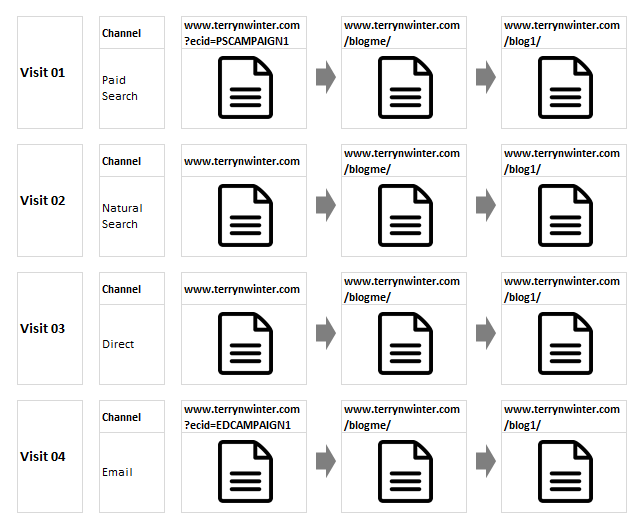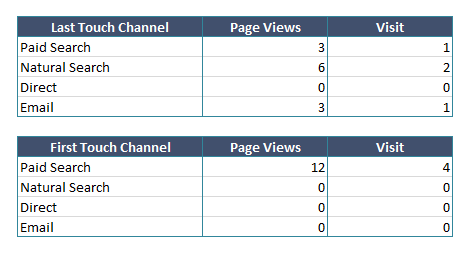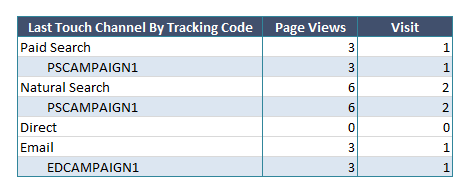Most of the time, we come across the topic or discussion on Last Touch Channel Versus Tracking Code. We will always try to break down the Last Touch Channels by Tracking Codes, and almost every time we are able to see that the Tracking Codes are under Organic Last Touch Channels such as Direct, Natural Search, Organic Social Media, etc. We think there are issues in Marketing Channel Set-up & Configuration, but actually not.
We need to understand that the Marketing Channel (Last Touch & First Touch) and the Tracking Code are different. Sub-relating them is not correct and will not produce any successful results even if the Marketing Channel has been configured using the Tracking Code or the URL Query String Parameter. Let us use the example below to understand this further.
Consider both the Tracking Code and the Marketing Channel were setup using the URL Query String Parameter ‘ecid‘ (Can be anything like ‘UTM’, ‘ecp’, ‘cid’ etc). Also, assume that the Marketing Paid Channels were configured in the following order followed by the Organic Channels such as Direct, Natural Search, Organic Social Media, etc.
‘ecid’ starts with ‘DI’ will fall under the Channel ‘Display’.
‘ecid’ starts with ‘ED’ will fall under the Channel ‘Email’.
‘ecid’ starts with ‘PS’ will fall under the Channel ‘Paid Search’.
So, whenever an ‘ecid’ URL is loaded, the landing page will capture the Tracking Code(s.campaign) and process the same for the Marketing Channel (Last Touch and First Touch).
Before entering the report, understand that the Tracking Code (s.campaign) is a conversion variable and, by default, the Tracking Code has the expiration ‘Week’. But the Last Touch and First Touch Channels are based on the Visit. So, let’s have the report!
Don’t be confused that Direct Channel didn’t get any credit because most of the time we wouldn’t have configured the Channel Override for Direct and Session Refresh Channels. See the link below for more information on Channel Override. Will try to write a separate blog on Marketing Channel Override.
If we assume that the visits are within the same week, the following is the Tracking Code report.
Now, let’s get to the subject that we started to discuss. If you breakdown the ‘Paid Search’ and the ‘Email’ Marketing Channel by Tracking Code, there is no brainier. But consider sub-relating the Natural Search by Tracking Code, since the Tracking Code expires only after a week, the Tracking Code will be persist/valid for Visitor 02 and Visit 03 (Captured in Visit 01). For Visit 04, the Tracking Code will be replaced, so there is nothing to discuss about it, so reporting will look like this!
Conclusion: Sub relating or breaking down the Last Touch or First Touch Channel by Tracking Code is not the correct way to understand the relationship between the Marketing Channel and the Tracking Code. So what do we have to do if we need to understand the relationship?
Marketing Channel Detail (Last Touch Channel Detail or First Touch Channel Detail) should be used. During the set-up of the Marketing Channel Processing Rules, we can properly define the same and understand the relationship between the Channel and the Channel details.
For more information on Visitor Engagement Expiration in Marketing Channel click here.











Hi Pratheep,
First of all, thank you for providing such clarity on how the marketing channel reports work.
I have two follow up questions on this:
1. When you have broken down the last touch channel by tracking code, the natural search’s visit changed from 2 to 1. I am not able to understand that.
2. In last touch channel, assuming this explanation is for the same user, why the last channel (which is email) is not overwriting all the channels? (meaning getting zero visits as they are not the last channel visited by that user)
Dear Roshan,
1. It was a miss. Thanks for the find, have changed it now.
2. If I understand you correctly, are you asking why Email didn’t overwrite all the channels to get 12 Page Views and 4 Visits in the table Last Touch Channel?
Thank You, Arun.
Super interesting read! So when it comes to attributing conversions/sales at a campaign level – is tracking code report the more accurate representative of a specific campaign performance? or would that be marketing channel detail?
Hello Sowmya, I would say Tracking Code. But depends on Business Requirement. Thanks, Arun.